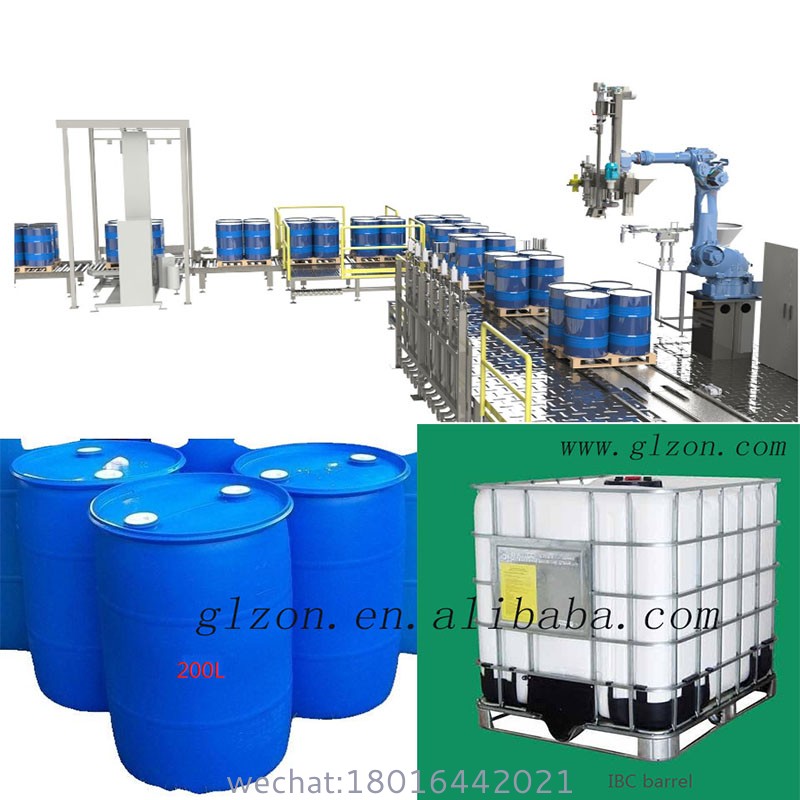Chemical Filling machine
Chemical Filling machine
- Brand:
- Model:
Chemical Filling machine
Chemical Filling machine
The automatic filling machine for chemical barrels is an automated equipment for accurately and efficiently filling chemical liquids or semi-fluid products. It is widely used in the chemical, petroleum, coating, food, pharmaceutical and other industries, and is suitable for filling large-capacity containers (such as 200L chemical barrels). The following is a detailed introduction to the automatic filling machine for chemical barrels:
Main features
High-precision filling:
Adopt high-precision flowmeter or weighing sensor to ensure the accuracy of the filling amount, and the error is usually controlled between ±0.1%-0.5%.
Automated operation:
The degree of automation is high, and it can realize automatic barrel loading, positioning, filling, metering, barrel unloading and other operations, reducing manual intervention.

Versatility:
Applicable to a variety of chemical liquids, such as acids, alkalis, solvents, resins, coatings, etc.
Suitable pumps and pipeline materials can be selected according to different material properties (such as viscosity, corrosiveness).
High safety:
The equipment adopts explosion-proof design and is suitable for flammable and explosive chemical environments.
Equipped with overflow, anti-drip and emergency stop functions to ensure safe operation.
High efficiency and energy saving:
The filling speed is fast, usually 1-2 barrels (200L) can be filled per minute.
Energy-saving design is adopted to reduce energy consumption.
Easy to clean and maintain:
The equipment has a simple structure, and the pipelines and pumps are easy to disassemble and clean, which meets the hygiene requirements of the chemical industry.
Main components
Filling system:
Includes filling head, pump, flow meter or weighing sensor for precise control of filling volume.
Conveying system:
Automatic conveyor belt or roller for conveying empty barrels to the filling position and removing the filled barrels.
Control system:
PLC (Programmable Logic Controller) and touch screen interface for setting filling parameters, monitoring operating status and fault diagnosis.
Safety protection system:
Includes explosion-proof motor, emergency stop button, overflow protection device, etc.
Auxiliary equipment:
Such as automatic capping machine, labeling machine, etc., can be linked with other equipment to realize a fully automated production line.
Working principle
The empty barrel enters the filling position through the conveying system.
The sensor detects the position of the barrel and fixes it.
The filling head descends to the barrel mouth, and the pump is started to inject the chemical liquid into the barrel.
The flow meter or weighing sensor monitors the filling volume in real time, and automatically stops filling when the set value is reached.
After the filling is completed, the filling head rises, the conveying system removes the full barrel, and the empty barrel enters the next filling cycle.
Selection points
Filling capacity:
Select the appropriate filling capacity (such as 100L, 200L, etc.) according to the needs.
Material characteristics:
Select the appropriate pump and pipeline material (such as stainless steel, PTFE, etc.) according to the viscosity, corrosiveness, flammability, etc. of the material.
Filling accuracy:
Select a high-precision flow meter or weighing system according to the process requirements.
Automation degree:
Select semi-automatic or fully automatic equipment according to production needs.
Safety certification:
Ensure that the equipment meets relevant industry standards such as explosion-proof and environmental protection.
Application scenarios
Chemical industry: filling of liquids such as acids, alkalis, solvents, resins, etc.
Coating industry: filling of paint, coating, diluent and other products.
Food industry: filling of food-grade liquids such as edible oil and syrup.
Pharmaceutical industry: filling of liquid medicine, API, etc.
Advantages
Improve production efficiency and reduce labor costs.
Ensure filling accuracy and reduce material waste.
Adapt to a variety of chemical liquids and have a wide range of applications.
Meet safety production and environmental protection requirements.
If you have specific needs or questions, you can provide more details and I can recommend more suitable equipment or solutions for you!